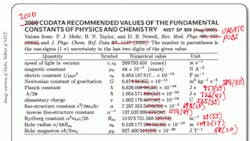Only constant in life is change
It turns out that the definitions of nature's fundamental constants are anything but. In fact, new scientific research shows that we've been underestimating electromagnetic force and overestimating gravity and the size of the smallest energy “quantum.” The National Institute of Standards and Technology (NIST) reports the latest internationally recommended values of these fundamental constants at physics.nist.gov/constants.
The values of constants — which range from the famous (speed of light) to the obscure (Wien frequency displacement law) — are adjusted every four years based on recent scientific knowledge. The new values are just in time for a worldwide vote on a plan to redefine the most basic units in the International System of Units (SI), such as the kilogram, exclusively in terms of the fundamental constants.
Values are determined by the international Committee on Data for Science and Technology (CODATA) Task Group on Fundamental Constants. The adjusted values reflect significant scientific developments over the past four years. For example, uncertainty in the value of the fine-structure constant alpha (α = 7.2973525698 × 10-3), which dictates the strength of the electromagnetic force, has been cut in half to 0.3 parts per billion. Because alpha can be measured in a range of phenomena, such as the magnetic properties of electrons, the consistency of the measurements correlates to the overall understanding of physics. Alpha will continue to be a vital constant after the SI redefinition, but it will remain an experimentally determined constant, while other SI units will be fixed.
The Planck constant h, which defines the size of the smallest possible quantum (or packet) of energy, is also being refined and is central to efforts to redefine the SI mass unit. The latest value of h (6.62606957 × 10-34 joule sec) takes into account a measurement of the number of atoms in a highly enriched silicon sphere. The 2010 values also include two new measurements of G, the Newtonian constant of gravitation, which dictates the strength of gravity. The latest value of G (6.67384 × 10-11 m3 kg-1 s-2) is roughly 66 parts per million smaller than the 2006 value.
A plan to adopt a completely constant-based SI, to be voted on this fall by the General Conference on Weights and Measures, is contingent upon the values of the fundamental constants reaching certain levels of precision that will require additional measurement advances in the future. For more information, visit nist.gov.
